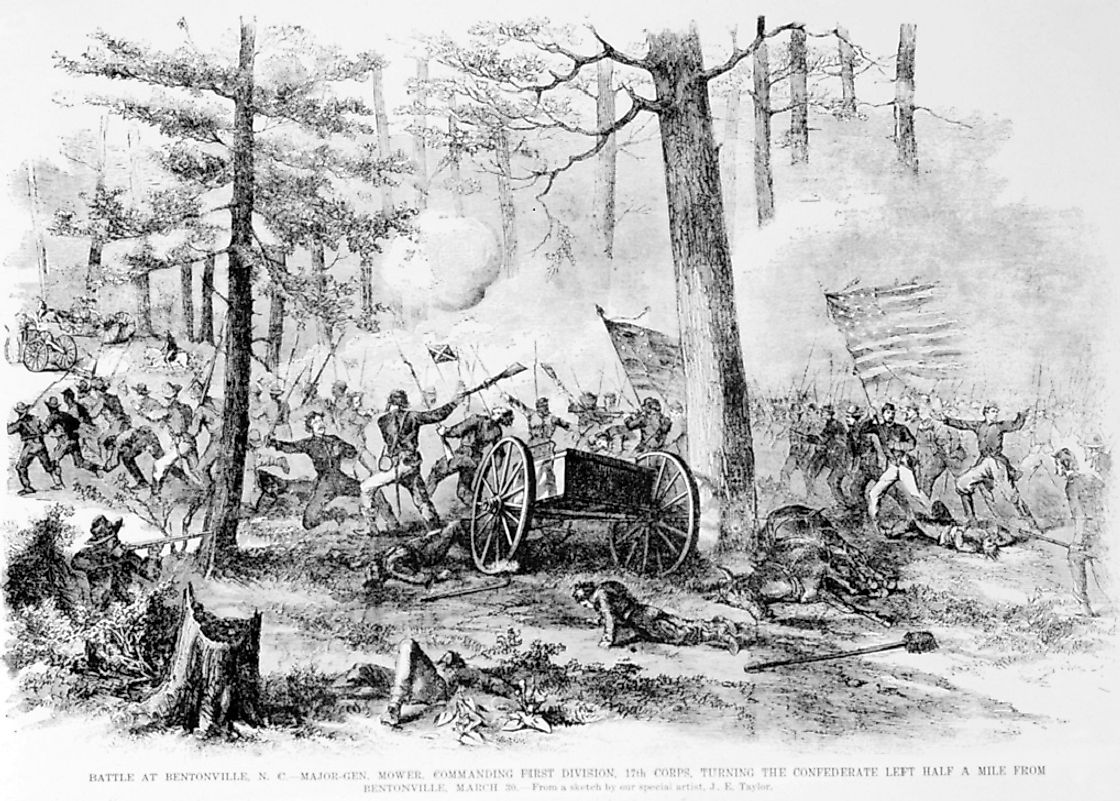The Battle of Bentonville: The American Civil War

5. Background
The Battle of Bentonville was fought from March 19th to March 21st, 1865. The battle, which is considered to the largest Civil War engagement on North Carolina soil, took place in Bentonville, North Carolina, near Four Oaks. An important part of the final stages of the Carolinas Campaign of the American Civil War, this battle was a desperate attempt by Confederate General Joseph Johnston to stop Union General William T. Sherman’s rapid, and devastating, drive through the Carolinas.
4. Makeup
The battle was fought between the Union (United States and the Confederacy (Confederate States of America, or C.S.A.). The Union army was led by Major General William T. Sherman, while the Confederate Army units fielded there were under the command of General Joseph E. Johnston. The units involved in the battle were the Union Military Division of the Mississippi, and the Confederate Army of the South. With a strength of 60,000 men, the ratio of men of the Union army almost outnumbered those of the Confederate Army by three-to-one, as the Confederate army consisted of around 21,900 men.
3. Description
After his March to the Sea, in which he captured Savannah, Georgia in the final months of 1864, Major General William T. Sherman led his army northward. His forces marched into the Carolinas, with his 60,000 men divided into two wings. In February, he captured Columbia, South Carolina, and moved on towards Goldsboro, North Carolina, where he planned to meet up with another army coming from the coast. His intention was to march all the way to Petersburg, Virginia, where he would join General Ulysses S. Grant and crush the army of Robert E. Lee, which was the largest Confederate force remaining. When General Joseph E. Johnston learned that Major General William T. Sherman's 60,000-man army was marching toward Goldsboro in two columns, he concentrated about 21,000 men into an area near the community of Bentonville. He planned to defeat the Union's left wing before it could be reinforced by the right, and hoped to prevent, or at least delay, Sherman's junction with Major General John M. Schofield's Federal reinforcements at Goldsboro. On the morning of March 19th, Sherman's Left Wing stumbled onto Johnston’s forces. This meeting occurred just as they were organized into a hook-shaped line at Cole's Plantation, blocking the Goldsboro Road there. The surprised Union army was initially driven back before a counterattack halted the advance of the Confederates. The next day, Johnston's Confederates pulled back their positions, and the arrival of more men from Union Right Wing reinforced the Union troops, which already far outnumbered Johnston’s army, and spelled impending doom for Confederate hopes in the battle.
2. Outcome
The battle continued on into March 21. As an attack from the Union army nearly cut off Johnston’s line of retreat, the Confederates were forced to begin to withdraw and escape from the Bentonville area. Over the course of the battle, the Confederates suffered about 2,600 casualties. These included 239 killed, 1,694 wounded, and 673 missing in action. With 194 killed, 1,112 wounded, and 221 missing, the Union army suffered a total of 1,527 casualties.
1. Significance
The battle was the last the last chance for a Confederate army to mount a serious attack on the advancing Union Army. Following the defeat, on April 26, 1865, Johnston laid down Confederate arms, on Sherman's terms, at Bennett Place near Durham. Bentonville was one of the final significant battles of the Civil War. Today, Bentonville Battlefield is maintained by the state of North Carolina in Johnston County. The state historic site, which is more than 10 square miles (6,500 acres) in area, is listed upon the U.S. National Register of Historic Places, and is a U.S. National Historic Landmark District.







